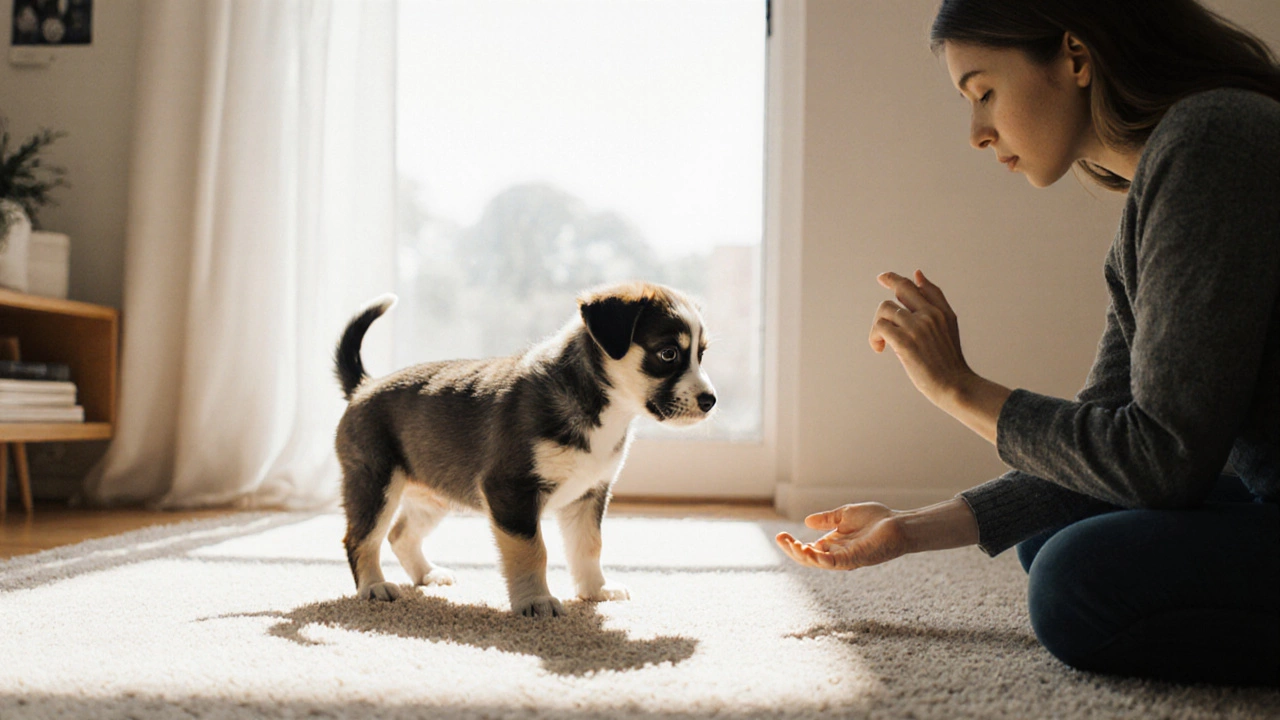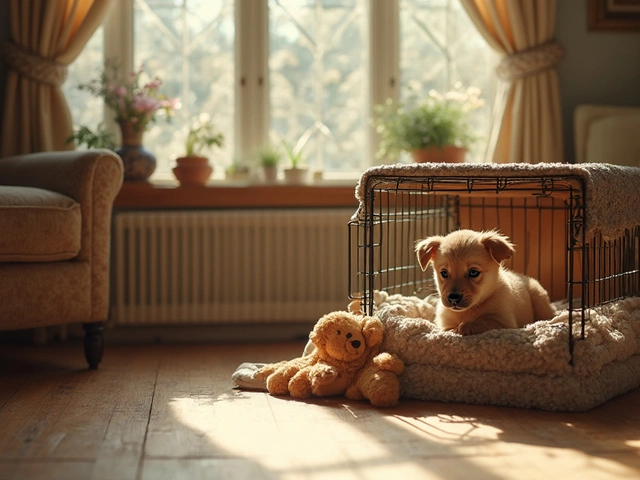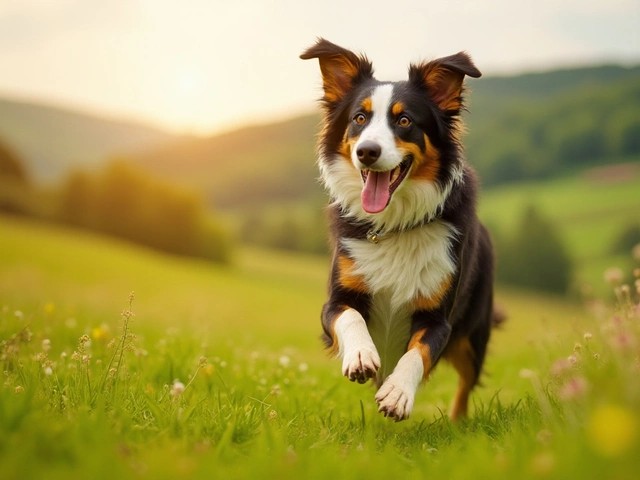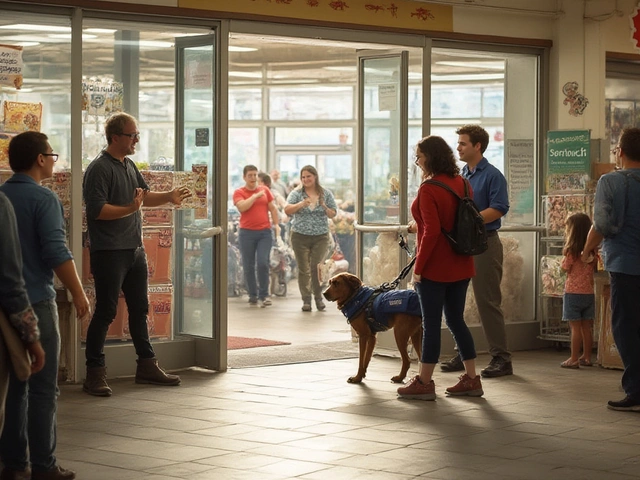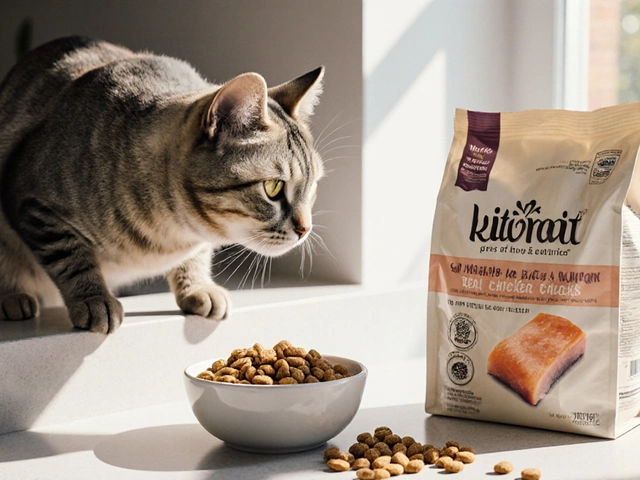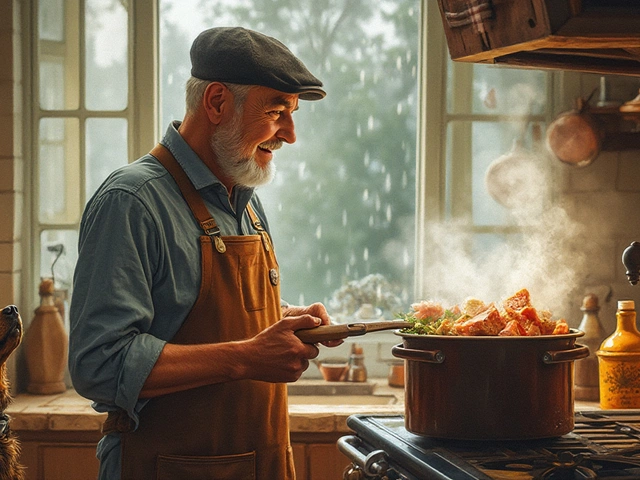Puppy Bladder Control Calculator
Calculate Your Puppy's Bladder Control
Understand how long your puppy can hold their bladder based on breed and age to prevent indoor accidents.
Results
Quick Takeaways
- Interrupt only if you can catch the action in the first few seconds.
- Use a firm cue, then redirect to the proper spot.
- Consistency, timing, and praise matter more than the interruption itself.
- Some breeds need extra patience because of slower bladder control.
- When in doubt, call a Veterinarian for a quick check.
Seeing a Puppy a young dog aged up to one year, still learning the rules of the house lift a leg or squat indoors can feel like a panic button. Do you shout, clap, or grab them? Or do you let it happen and keep the peace? The answer isn’t a one‑size‑fits‑all and depends on timing, the cue you use, and what you do right after the interruption.
Below we break down the science behind puppy peeing inside, the pros and cons of breaking the act, and a step‑by‑step plan that lets you stay calm while teaching good habits.
What’s actually happening when a puppy pees inside?
First, understand the behavior. A puppy’s bladder is tiny - a two‑month‑old can hold only about 30‑40 ml of urine. Their urge to go can appear suddenly, especially after drinking, waking up, or playing.
When they start to squat, they’re already in “elimination mode.” This includes a scent‑marking instinct, a need to communicate, and a search for a safe spot. If the environment feels safe, they’ll finish the job.
Key Urination cue the signal you give when you want the puppy to stop and go outside is crucial. A clear cue lets the puppy know you’ve noticed the behavior and that a different location is expected.
Should you interrupt? The pros and cons
Interrupting the act can work, but only if you do it correctly. The table below shows the main trade‑offs.
| Approach | Pros | Cons |
|---|---|---|
| Interrupt early (within 2‑3 seconds) | Shows the pup you’re paying attention; can be redirected quickly. | If timing’s off, the puppy may feel confused or scared. |
| Let finish, then clean | Reduces anxiety; no risk of startling the pup. | Misses a teaching moment; may reinforce indoor spot. |
| Use a consistent cue every time | Builds a reliable pattern; works for all breeds. | Requires patience and strict consistency. |
How to interrupt the right way
- Spot the cue. Watch for the “squat,” tail‑wag, sniffing pattern, or a sudden stop in play. The earlier you catch it, the easier the redirection.
- Positive reinforcement rewarding the dog for the desired behavior cue: say a short, firm word like “No‑go” or “Outside!” The tone should be calm but confident.
- Immediately Crate training using a safe enclosure to manage the puppy’s location when unsupervised or guide them to the nearest outdoor spot. If you have a pee pad, you can lead them there for a quick finish, then move to the real yard.
- When they finish outdoors, Positive reinforcement again - a treat, a happy “Good boy!” and a quick pet.
- Return to the indoor area cleanly. Use an enzymatic cleaner to erase the scent; otherwise the puppy may return to the same spot.
Why timing matters more than the interruption itself
Research from the University of Bristol’s Animal Behaviour Unit (2024) showed that puppies whose owners interrupted within two seconds learned the “outside‑only” rule 30 % faster than those who waited longer. The key was “association speed” - the quicker the pup links the cue to the action, the stronger the learning.
That doesn’t mean you have to become a superhero. If you miss the exact moment, just stay calm, clean up, and reinforce the next correct outing.
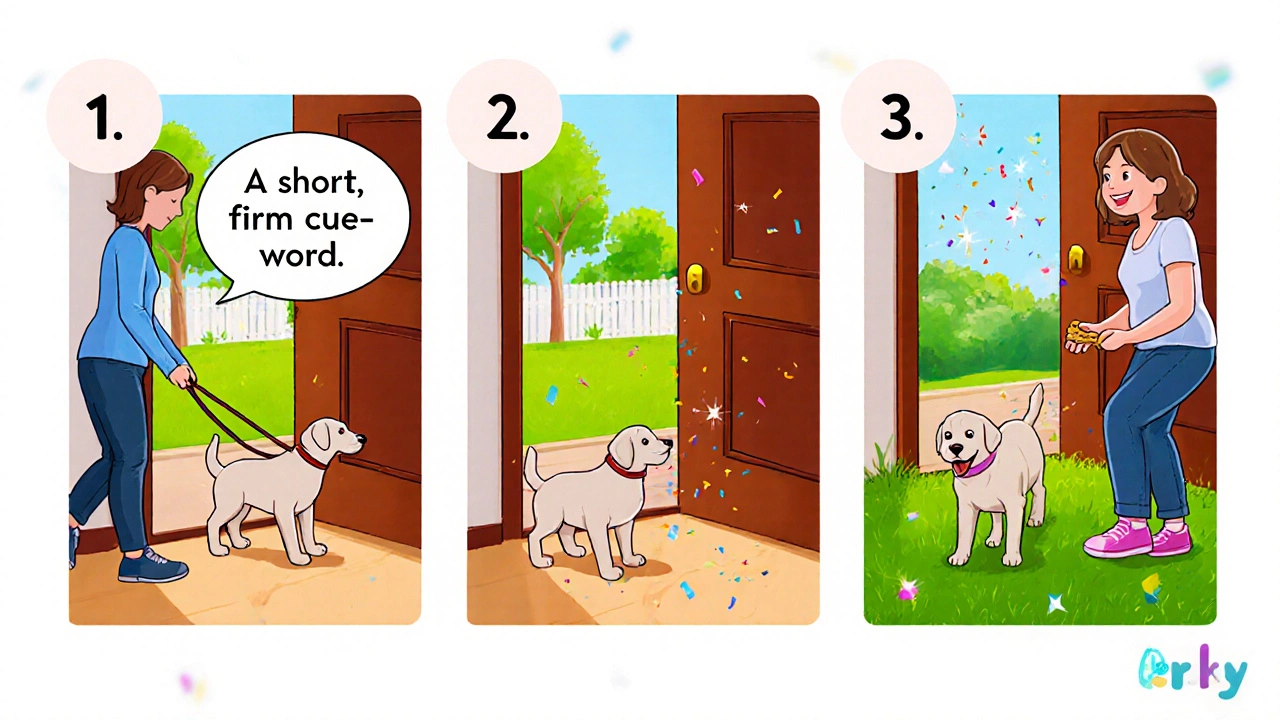
Breed differences and bladder control
Some breeds have naturally slower bladder development. Toy breeds (e.g., Chihuahua, Pomeranian) have tiny bladders and may need a bathroom break every hour. Larger breeds (e.g., Labrador, German Shepherd) can hold longer but still need a routine.
Understanding your breed’s typical Bladder control the ability to hold urine for extended periods helps set realistic expectations for indoor accidents.
Do you need a Veterinarian a medical professional for animal health?
If accidents happen repeatedly despite a solid routine, it could be a medical issue: urinary tract infection, bladder stones, or incontinence. A quick vet visit rules out health problems and gives you peace of mind.
Common pitfalls and how to avoid them
- Inconsistent cues. Switching between “No,” “Stop,” and “Outside!” confuses the pup. Pick one phrase and stick with it.
- Punishing after the fact. Scolding hours later does nothing; the puppy won’t connect the punishment to the accident.
- Leaving the puppy unsupervised. Use a Crate a safe enclosure for managing a puppy’s environment or a gated area to keep an eye on them.
- Skipping the cleanup. The scent left behind acts like a “welcome sign.” Enzymatic cleaners break down the odor molecules.
- Ignoring schedule. Puppies thrive on predictable feeding, water, and bathroom times. A consistent Schedule a set routine for meals and bathroom breaks reduces surprise accidents.
Step‑by‑step house‑training plan
- Establish a routine. Feed at the same times each day, and take the puppy out 10‑15 minutes after meals, play, and naps.
- Choose a cue. Use a short word like “Go‑outside!” and say it every time you open the door.
- Supervise. Keep the pup in view or use a Crate when you can’t watch directly.
- Interrupt early. If you see the Urination cue, use your chosen word, then gently guide them to the door.
- Reward immediately. As soon as they finish outside, give a treat and enthusiastic praise.
- Clean accidents. Use enzymatic cleaner, then reset the area with a fresh pad or a toy to distract.
- Adjust for breed. If you have a small breed, plan more frequent outings; larger breeds may need fewer trips.
- Monitor progress. Keep a simple log: date, time, cue used, success or accident. Patterns will emerge.
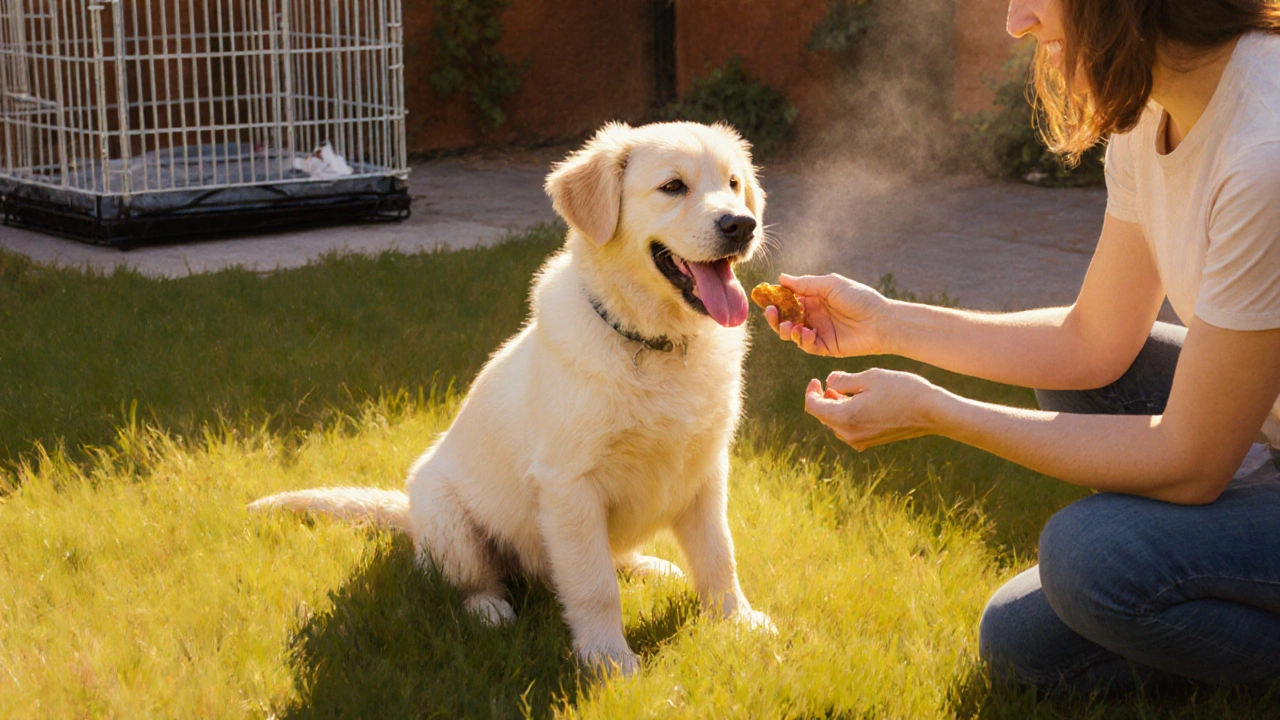
What about pee pads?
Many owners wonder if a pee pad helps or hurts the training process. If you plan to transition to fully outdoor bathroom habits, use pads only as a temporary stop‑gap. Place the pad near the door, then slowly move it closer to the outside each week. The goal is to keep the scent trail leading outdoors.
When to consider Neutering the surgical removal of reproductive organs to prevent breeding
Neutering can reduce marking behavior in some males, but it doesn’t replace proper training. If your puppy is a male who frequently lifts a leg inside, neutering may lower the urge over time, but you still need the cue‑and‑reward system.
Final thoughts
The short answer: yes, you can interrupt a puppy’s indoor peeing, but only if you’re quick, consistent, and follow up with a clear direction and reward. Think of the interruption as a traffic light - a brief red that tells the puppy to stop and then shows the green path outside.
Keep the routine steady, clean up the smells, and remember that patience beats panic. Your pup will catch on, and soon the only place you’ll find them squatting will be the backyard.
Frequently Asked Questions
How soon should I interrupt after I see the cue?
Aim for the first two to three seconds. Anything longer risks the puppy finishing the act, which makes the cue less effective.
Is it okay to use a loud bark or clapping?
A loud sound can startle the pup and create fear. A calm, firm word works better and keeps the training positive.
My puppy keeps having accidents after I’ve started crating. Why?
The crate may be too big, allowing the puppy to use one corner as a bathroom. Keep the crate just big enough for a bed and a water bowl, and take the pup out right after opening it.
Should I switch to a different cue if my puppy doesn’t respond?
First, check the timing. If the cue was late, the pup might not link it to the action. Once timing is right, stick with one cue; changing it creates confusion.
When should I call the vet about indoor peeing?
If accidents happen more than three times a day despite a consistent schedule, or if you notice blood, straining, or a foul smell, book a vet visit right away.

